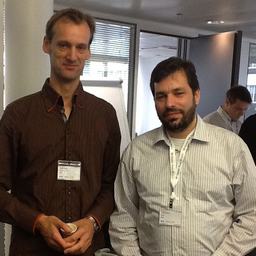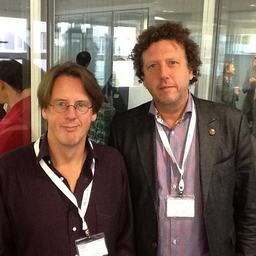The recently launched European Human Brain Project (HBP) aims to have a full computer simulation of a functioning human brain ready in ten years. In the ramp-up phase, which covers a 30 month period, three Dutch groups are active. A considerable amount of funding for the HBP is available through open calls, and we are happy to announce that the HBP recently increased its footprint in The Netherlands by adding five members to the consortium (Leiden UMC, KNAW, Synaptologics BV, Univ. Maastricht, UvA). The three groups that are already active at the ramp-up phase present themselves below.
 Paul Tiesinga (R) and coworker Rembrandt Bakker (L) at the 2013 HBP summit
Paul Tiesinga (R) and coworker Rembrandt Bakker (L) at the 2013 HBP summit1. Paul Tiesinga (Donders Institute for Brain, Cognition and Behaviour, Radboud University Nijmegen)
Paul Tiesinga heads the Predictive Neuroinformatics work package of the Neuroinformatics subproject, which aims to develop new tools using machine learning and statistical modeling techniques to extract rules describing the relationships between datasets for different levels of brain organisation. Such a statistical model will make it possible to derive a “global neuronal addressing system” that can predict the targets and the course of long-range axonal projections from specific types of neurons to their targets in the rest of the brain. A second task within this work package is to develop algorithms that use the statistical structure of neuronal and synaptic geometries to computationally synthesise model neurons and synapses (task leader; Pedro Larrañaga, at the Technical University of Madrid).
 Huib Mansvelder and Guus Smit at the 2013 HBP summit
Huib Mansvelder and Guus Smit at the 2013 HBP summit2. Huib Mansvelder, Guus Smit (Center for Neurogenomics and Cognitive Research, VU University Amsterdam)
Despite gross morphological similarities, human and mouse neurons show important differences in shape. Human cortical pyramidal neurons have a larger dendritic complexity and are covered by larger densities and numbers of spines. Whether human neurons and synapses differ in functional properties is poorly understood due to a lack of available data on human neuron physiology and the underlying molecular synaptic composition. To address this, HBP seeks strategic reference data sets on human single-cell recordings in which detailed single-cell and microcircuit anatomy is linked with physiological recordings of cellular and synaptic properties. Thereto, we will in the ramp-up phase of HBP identify which groups in the world are recording from neurons in brain slices obtained from human tissue that had to be removed for surgical treatment of deeper structures. With these groups, we will discuss which data sets are available and which data is lacking to built these reference data sets. In the operational phase of HBP, these data sets can then be constructed by a joined effort in recording and reconstructing human synapses and neurons. Ideally, physiological data and molecular data will be obtained and integrated from these recorded human neurons, which should elucidate cell-type and/or cortical layer specific physiology and molecular organization.
 Martin Kersten and coworker Ying Zhang at the 2013 HBP summit
Martin Kersten and coworker Ying Zhang at the 2013 HBP summit3. Martin Kersten (Department of Information Systems, CWI Amsterdam)
Martin Kersten is the representative of CWI in the High Performance Computing Platform subproject of the Human Brain Project. The overall goal of this subproject is to provide the
HBP Consortium and the broader European neuroscience community with supercomputing, Big Data and Cloud capabilities at the exascale, as well as the system software, middleware, interactive computational steering and visualisation support necessary to create and simulate multi-scale brain models and to address the hard-scaling challenges of whole brain modelling.


 Paul Tiesinga (R) and coworker Rembrandt Bakker (L) at the 2013 HBP summit
Paul Tiesinga (R) and coworker Rembrandt Bakker (L) at the 2013 HBP summit Huib Mansvelder and Guus Smit at the 2013 HBP summit
Huib Mansvelder and Guus Smit at the 2013 HBP summit Martin Kersten and coworker Ying Zhang at the 2013 HBP summit
Martin Kersten and coworker Ying Zhang at the 2013 HBP summit

